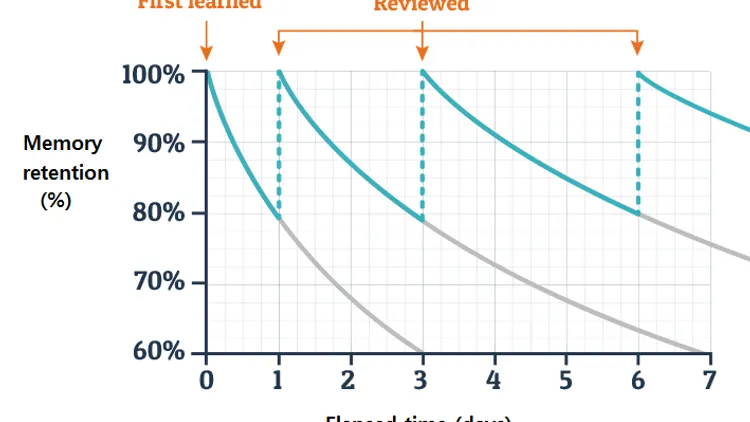
Using Spaced Repetition Techniques to Elevate College Studying
As a new college student, I’ve been experimenting with various studying systems.
I set two primary goals for studying:
- Achieve high grades
- Increase free time (make studying more efficient)
The first is fairly obvious, but the second goal was more impactful on the strategies I tested since increasing efficiency is less straightforward.
Let’s first look at one of the problems I found with some common ways to study.
Why You Need Data for Studying
A basic way to study is to take linear notes in class, then review them before the test, along with some practice problems (depending on the class).
A problem arises when you have a significant amount of information to learn for an upcoming assessment.
How do you know what to study?
You could studying everything, but there’s no guarantee you’ll have enough time to fit that in along with all your other work.
Even if you do study everything, you won’t necessarily remember all of the information you reviewed.
To be efficient, you need to know what to study, and when.
This means that you need data on how well you know relevant information to make accurate studying decisions.
How to Use Data to Study
This strategy is based on combining spaced repetition flashcards with retrospective revision timetables.
What Is Spaced Repetition?
Spaced repetition commonly involves creating flashcards for individual concepts.
The spaced part comes from something called the forgetting curve, which suggests that you should review information when you are about to forget it.
Common spaced repetition systems like Anki use some relatively simple math to determine when you should review your flashcards.
What Are Retrospective Revision Timetables?
This idea first came to me from Ali Abdaal on YouTube.
He explains that for each course, you create a table listing each main topic in the course, where you track how recently you reviewed each topic.
Here’s an example from a recent course of mine:
Notice I also highlight the date in a color representing how well I did with the content.
| Section | |||||||
|---|---|---|---|---|---|---|---|
| 1.3 Conic Sections | Aug 26 | Aug 28 | Aug 31 | Sep 7 | Sep 14 | Sep 26 | |
| 1.2 Vectors | Aug 26 | Aug 28 | Aug 31 | Sep 6 | Sep 14 | Sep 21 | Oct 8 |
| 2 Vector-Valued Functions | Aug 31 | Sep 2 | Sep 7 | Sep 14 | Sep 19 | Oct 2 | Oct 12 |
| 3-4 Differentiation in N-Dimensions | Sep 6 | Sep 18 | Sep 21 | Oct 8 | Oct 12 | ||
| Optimization and Lagrange Multiplier | Sep 29 | Oct 8 | |||||
| 5 Double and Triple Integration | Oct 6 | Oct 11 |
During study sessions, you review the material you are weakest with (based on how long ago you reviewed it, and how strongly you rated your knowledge of it).
These study sessions can fit in at an time, and you decide what to study each time in the same way.
In this way, retrospective revision timetables become a high-level spaced repetition technique.
How Can These Systems Be Combined?
I primarily follow the retrospective revision timetable system to determine what I need to study at a high level.
In class, I take notes in a standard way, on my iPad in Goodnotes (there are free alternatives).
I then extract the important information into flashcards in Obsidian (using the Spaced Repetition plugin).
Note: Obsidian and the spaced repetition plugin support LaTeX for math and code blocks for CS.
I create a retrospective revision timetable for each course in Obsidian as well, so I can link them to the notes pages.
When I review a topic, I use the spaced repetition plugin, which displays flashcards and tracks how well I know each piece of information on an individual level.
By combining these systems together, I have a macro and micro view into my own knowledge, allowing me to study more effectively.
How This System Has Worked So Far
I recently started college, so I have only completed a handful of courses.
The system has worked so far, freeing time for personal projects and clubs in addition to my classes.
My grades have been consistent as well, with any dropped points being a personal mistake rather than a lack of knowledge (a good sign for this system, not for me).
I will continue to use this system unless I determine that there is a better alternative. In that case, I will update this article with my new findings.
Feel free to reach out with any questions, or with feedback on this system!